Meru Networks AP433E IEEE 802.11N ACCESS POINT User Manual AP400
Meru Networks Inc. IEEE 802.11N ACCESS POINT AP400
USERS MANUAL

Meru AP400
Installation Guide
Copyright © Meru Networks, Inc., 2003–2010. All rights reserved.
Other names and brands may be claimed as the property of others.
April 2011
Document Number: 882-70016 Rev A Rel 4.1 Ver 1 AP400 Installation Guide
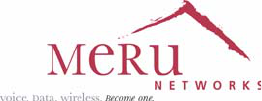
iii
MERU NETWORKS, INC.
Limited Product Warranty
This Limited Product Warranty applies to the original end-user customer of the Meru
product which you purchased for your own use, and not for resale (“Product”), from
Meru Networks, Inc. (“Meru”) or its authorized reseller (“Reseller”).
Limited Warranties
—One-year limited hardware warranty: Meru warrants to you that Meru
hardware (other than Third Party Products as described below) will be
free from defects in materials and workmanship for a one-year period
after the date of delivery of the applicable product to you from Meru or
its Reseller (the “Hardware Warranty Period”). If Meru receives written
notice from you of such defects during the Hardware Warranty Period,
Meru will, at its option, either repair or replace Meru hardware that
Meru determines to be defective. Replacement products may be
remanufactured units, and will be warranted for the remainder of the
original Hardware Warranty Period, or if greater, for thirty days from
delivery of such replacement. Should Meru be unable to repair or
replace the Meru hardware, Meru (or its Reseller, as applicable) will
refund to you the purchase price of the Product.
—90-Day Limited Software Warranty: Meru warrants to you that, for a 90-
day period after the date of delivery of the applicable product to you
from Meru or its Reseller (the “Software Warranty Period”), when
properly installed and used, (a) the media on which the Meru software
is provided will be free from defects in materials or workmanship; and
(b) the Meru software will substantially conform to the functional
specifications in the applicable documentation. If Meru receives
written notice from you of a breach of this warranty during the Software
Warranty Period and is able to reproduce the defect, Meru will, at its
option, either repair or replace the defective Meru software. Should
Meru be unable to repair or replace the Meru software, Meru (or its
Reseller, as applicable) will refund to you the purchase price of the
Product.
Exclusions
The warranty on the Product shall not apply to defects resulting from the following:
iv Meru Access Point Installation Guide
—Alteration or modification of the Product in any way, including without
limitation configuration with software or components other than those
supplied by Meru or integration with parts other than those supplied by
Meru.
—Abuse, damage or otherwise being subjected to problems caused by
negligence or misapplication (including without limitation improper or
inadequate maintenance or calibration), relocation of the products
(including without limitation damage caused by use of other than Meru
shipping containers), or use of the products other than as specified in
the applicable Meru product documentation (including without
limitation incompatible operating environments and systems), or
improper site preparation or maintenance.
—Damage as a result of accidents, extreme power surge, extreme
electromagnetic field, acts of nature or other causes beyond the control
of Meru.
—Use of the Product with software, interfacing, parts or supplies not
supplied by Meru.
The warranty on the Product does not apply if the Product is sold, or in the case of
software, licensed, for free for evaluation or demonstration purposes.
Meru expressly disclaims any warranty or obligation to support the Product for all
operating environments – for example, as illustration and not limitation, Meru does
not warrant or ensure interoperability of the Product with future telecommunica-
tion systems or other future software or hardware.
You understand and acknowledge that the Products may generate, use or radiate
radio frequency energy and may interfere with radio communications and/or radio
and television receptions if is not used and/or installed in accordance with the
documentation for such products. WHILE MERU USES COMMERCIALLY REASONABLE
EFFORTS TO ENSURE COMPLIANCE OF THE PRODUCTS WITH APPLICABLE UNITED
STATES FEDERAL COMMUNICATIONS COMMISSION AND PROTECT AGAINST HARMFUL
INTERFERENCES, YOU ACKNOWLEDGE AND AGREE THAT INTERFERENCES WITH
RADIO COMMUNICATIONS AND/OR RADIO AND TELEVISION RECEPTIONS MAY OCCUR
AND THAT MERU WILL NOT BE LIABLE FOR ANY DAMAGES OR INCONVENIENCE BASED
ON SUCH INTERFERENCES.
Third Party Products - The above Limited Warranties are exclusive of products
manufactured by third parties (“Third Party Products”). If such third party manu-
facturer provides a separate warranty with respect to the Third Party Product, Meru
will include such warranty in the packaging of the Meru Product.
Return procedures
To obtain warranty service you must: (a) obtain a return materials authorization
number (“RMA#”) from Meru by contacting rmaadmin@merunetworks.com, and (b)
deliver the Product, in accordance with the instructions provided by Meru, along
with proof of purchase in the form of a copy of the bill of sale including the
Product’s serial number, contact information, RMA# and detailed description of the
defect, in either its original package or packaging providing the Product with a
v
degree of protection equivalent to that of the original packaging, to Meru at the
address below. You agree to obtain adequate insurance to cover loss or damage to
the Product during shipment.
If you obtain an RMA# and return the defective Product as described above, Meru
will pay the cost of returning the Product to Meru. Otherwise, you agree to bear
such cost, and prior to receipt by Meru, you assume risk of any loss or damage to
the Product. Meru is responsible for the cost of return shipment to you if the Meru
Product is defective.
Returned products which are found by Meru to be not defective, returned out-of-
warranty or otherwise ineligible for warranty service will be repaired or replaced
at Meru’s standard charges and shipped back to you at your expense.
At Meru’s sole option, Meru may perform repair service on the Product at your
facility, and you agree to provide Meru with all reasonable access to such facility
and the Product, as required by Meru. On-site repair service may be available and
is governed by the specific terms of your purchase.
All replaced parts, whether under warranty or not, are the property of Meru.
Warranty limitations
THE WARRANTIES SET FORTH ABOVE ARE EXCLUSIVE AND NO OTHER WARRANTY,
WHETHER WRITTEN OR ORAL, IS EXPRESSED OR IMPLIED BY MERU, TO THE MAXIMUM
EXTENT PERMITTED BY LAW. THERE ARE NO OTHER WARRANTIES RESPECTING THE
PRODUCT AND DOCUMENTATION AND SERVICES PROVIDED UNDER THIS AGREEMENT,
INCLUDING WITHOUT LIMITATION ANY WARRANTY OF DESIGN, MERCHANTABILITY,
FITNESS FOR A PARTICULAR PURPOSE (EVEN IF MERU HAS BEEN INFORMED OF SUCH
PURPOSE), TITLE OR AGAINST INFRINGEMENT OF THIRD PARTY RIGHTS. IF ANY
IMPLIED WARRANTY CANNOT BE DISCLAIMED UNDER APPLICABLE LAW, THEN SUCH
IMPLIED WARRANTY SHALL BE LIMITED IN DURATION TO THE HARDWARE AND SOFT-
WARE WARRANTY PERIODS DESCRIBED ABOVE.
NO AGENT OF MERU IS AUTHORIZED TO ALTER OR EXCEED THE WARRANTY OBLIGA-
TIONS OF MERU.
MERU SPECIFICALLY DOES NOT WARRANT THAT THE MERU SOFTWARE WILL BE ERROR
FREE OR OPERATE WITHOUT INTERRUPTION.
THE REMEDIES IN THIS LIMITED PRODUCT WARRANTY ARE YOUR SOLE AND EXCLUSIVE
REMEDIES, AND MERU’S SOLE AND EXCLUSIVE LIABILITY, FOR BREACH OF THE HARD-
WARE OR SOFTWARE WARRANTY SET FORTH ABOVE.
Limitations of Liability
You acknowledge and agree that the consideration which you paid to Meru does not
include any consideration by Meru of the risk of consequential, indirect or inci-
dental damages which may arise in connection with your use of, or inability to use,
the Product. THUS, MERU AND ITS RESELLER WILL NOT BE LIABLE FOR ANY INDI-
RECT, INCIDENTAL, SPECIAL, PUNITIVE OR CONSEQUENTIAL DAMAGES, INCLUDING
WITHOUT LIMITATION LOST PROFITS, LOST BUSINESS, LOST DATA, LOSS OF USE, OR
vi Meru Access Point Installation Guide
COST OF COVER INCURRED BY YOU ARISING OUT OF OR RELATED TO YOUR PURCHASE
OR USE OF, OR INABILITY TO USE, THIS PRODUCT OR THE SERVICES, UNDER ANY
THEORY OF LIABILITY, WHETHER IN AN ACTION IN CONTRACT, STRICT LIABILITY,
TORT (INCLUDING NEGLIGENCE) OR OTHER LEGAL OR EQUITABLE THEORY, EVEN IF
MERU OR ITS RESELLER KNEW OR SHOULD HAVE KNOWN OF THE POSSIBILITY OF
SUCH DAMAGES. IN ANY EVENT, THE CUMULATIVE LIABILITY OF MERU OR ITS
RESELLER FOR ALL CLAIMS WHATSOEVER RELATED TO THE PRODUCT OR THE SERVICE
WILL NOT EXCEED THE PRICE YOU PAID FOR THE PRODUCT OR SERVICES GIVING RISE
TO SUCH CLAIMS.
THE LIMITATIONS SET FORTH HEREIN ARE INTENDED TO LIMIT THE LIABILITY OF MERU
AND ITS RESELLERS AND SHALL APPLY NOTWITHSTANDING ANY FAILURE OF ESSEN-
TIAL PURPOSE OF ANY LIMITED REMEDY.
The jurisdiction applicable to you may not allow the limitations of liability or
damages set forth above, in which case such limitation shall only apply to you to
the extent permitted in such jurisdiction.
Additional Information
This Limited Product Warranty shall be governed by and construed in accordance
with the laws of the State of California, U.S.A., exclusive of its conflict of laws prin-
ciples. The U.N. Convention on Contracts for the International Sale of Goods shall
not apply.
This Limited Product Warranty is the entire and exclusive agreement between you
and Meru with respect to its subject matter, and any modification or waiver of any
provision of this statement is not effective unless expressly set forth in writing by
an authorized representative of Meru.
All inquiries or claims made under this Limited Product Warranty must be sent to
Meru at the following address:
Meru Networks Inc.,
894 Ross Drive, CA 94087, USA
Tel: 408-215-5300
Fax: 408-215-5301
Email: support@merunetworks.com
© 2010 Meru Networks, Inc. Contents vii
Contents
About This Guide . . . . . . . . . . . . . . . . . . . . . . .ix
Audience . . . . . . . . . . . . . . . . . . . . . . . . . ix
Other Sources of Information . . . . . . . . . . . . . . . . . . ix
Meru Publications . . . . . . . . . . . . . . . . . . . . . ix
Website Resources . . . . . . . . . . . . . . . . . . . . ix
External References . . . . . . . . . . . . . . . . . . . . x
Typographic Conventions . . . . . . . . . . . . . . . . . . . x
Contacting Meru . . . . . . . . . . . . . . . . . . . . . . xi
Customer Services and Support . . . . . . . . . . . . . . . . xi
Chapter 1
Access Points. . . . . . . . . . . . . . . . . . . . . . . . . 1
AP400 . . . . . . . . . . . . . . . . . . . . . . . . . . 2
Chapter 2
Installing AP400 . . . . . . . . . . . . . . . . . . . . . . . 5
Safety Precautions . . . . . . . . . . . . . . . . . . . . . . 5
Unpack the AP400 . . . . . . . . . . . . . . . . . . . . . . 6
Determine Power Requirements . . . . . . . . . . . . . . . . . 6
802.af PoE Usage . . . . . . . . . . . . . . . . . . . . . 6
802.3at PoE Usage. . . . . . . . . . . . . . . . . . . . . 7
Installation Requirements . . . . . . . . . . . . . . . . . . . 7
Additional Equipment . . . . . . . . . . . . . . . . . . . 8
Install the AP400 . . . . . . . . . . . . . . . . . . . . . . 8
Select a Location . . . . . . . . . . . . . . . . . . . . . 8
Attach the Provided Antennas. . . . . . . . . . . . . . . . . 9
Install the Access Point . . . . . . . . . . . . . . . . . . . 10
Check AP400 LED Activity . . . . . . . . . . . . . . . . . . . 14
Where to Go From Here . . . . . . . . . . . . . . . . . . . . 15
Cautions and Warnings . . . . . . . . . . . . . . . . . . . 17
Cautions . . . . . . . . . . . . . . . . . . . . . . . . . 17
Warnings . . . . . . . . . . . . . . . . . . . . . . . . . 19
Regulatory Information . . . . . . . . . . . . . . . . . . . 23
For AP400 . . . . . . . . . . . . . . . . . . . . . . . . . 23
Radio . . . . . . . . . . . . . . . . . . . . . . . . . 23
EMC. . . . . . . . . . . . . . . . . . . . . . . . . . 23
Safety . . . . . . . . . . . . . . . . . . . . . . . . . 23
USA . . . . . . . . . . . . . . . . . . . . . . . . . . . 25
viii Meru Access Point Installation Guide © 2010 Meru Networks, Inc.
Underwriters Laboratories . . . . . . . . . . . . . . . . . 25
FCC Radiation Exposure Statement . . . . . . . . . . . . . . 25
Radio Frequency Interference Requirements . . . . . . . . . . . 25
Canada. Industry Canada (IC) . . . . . . . . . . . . . . . . . 27
Europe—EU Declaration of Conformity and Restrictions . . . . . . . . 29
IEEE 802.11a Restrictions. . . . . . . . . . . . . . . . . . 31
EEE 802.11b/g Restrictions . . . . . . . . . . . . . . . . . 31
Japan. . . . . . . . . . . . . . . . . . . . . . . . . . 32
Singapore . . . . . . . . . . . . . . . . . . . . . . . 32
Manufacturing Information . . . . . . . . . . . . . . . . . . 32
Supported PoEs . . . . . . . . . . . . . . . . . . . . . . . 33
Supported Power Over Ethernet Devices for Meru APs . . . . . . . . . 33

© 2010 Meru Networks, Inc.About This Guide About This Guide ix
About This Guide
This guide provides installation instructions for the Meru AP400s, which includes both
the AP400 and the AP400i models. The term access point is used interchangeably
throughout this document to apply to any model when there are no differences
among the models.
Audience
This guide is intended for anyone installing Meru Wireless LAN System Access Points
(APs).
Other Sources of Information
Additional information is available in the following Meru publications, Web site, and
external references.
Meru Publications
Meru System Director Release Notes
Meru System Director Getting Started Guide
Meru Controller Installation Guide
Meru System Director Command Reference
Meru System Director Configuration Guide
Website Resources
For the first 90 days after you buy a Meru controller, you have access to online
support. If you have a support contract, you have access for the length of the
contract. See this web site for information such as:
Meru System Director Release Notes
Knowledge Base (Q&A)

© 2010 Meru Networks, Inc.About This Guide About This Guide x
Downloads
Open a ticket or check an existing one
Customer Discussion Forum
The URL is: http://support.merunetworks.com
Meru System Director Getting Started Guide
Meru Controller Installation Guide
Meru System Director Release Notes
Meru System Director Configuration Guide
Meru System Director Command Reference
External References
Stevens, W. R. 1994. TCP/IP Illustrated, Volume 1, The Protocols. Addison-Wesley,
Reading, Mass.
Gast, M.S. 2002. 802.11 Wireless Networks, The Definitive Guide. O’Reilly and
Associates, Sebastopol, Calif.
Typographic Conventions
This document uses the following typographic conventions to help you locate and
identify information:
Note:
Provides extra information, tips, and hints regarding the topic.
Caution!
Identifies important information about actions that could result in
damage to or loss of data, or could cause the application to behave in
unexpected ways.
Warning!
Identifies critical information about actions that could result in
equipment failure or bodily harm.

© 2010 Meru Networks, Inc.About This Guide About This Guide xi
Contacting Meru
You can visit Meru Networks, Inc. on the Internet at this URL:
http://www.merunetworks.com
Customer Services and Support
For assistance, contact Meru Customer Services and Support 24 hours a day at
+1-888-637-8952 (+1-888-Meru-WLA(N)) or +1-408-215-5305. Email can be sent to
support@merunetworks.com.
Meru Networks, Inc. Customer Services and Support provide end users and channel
partners with the following:
Telephone technical support
Software update support
Spare parts and repair service
RMA Procedures
Contact Meru Customer Services and Support for a Return Material Authorization
(RMA) for any Meru equipment.
Please have the following available when making a call:
Company and contact information
Equipment model and serial numbers
Meru software release and revision numbers (for example, 3.0.0-35)
A description of the symptoms the problem is manifesting
Network configuration
© 2010 Meru Networks, Inc.About This Guide About This Guide xii
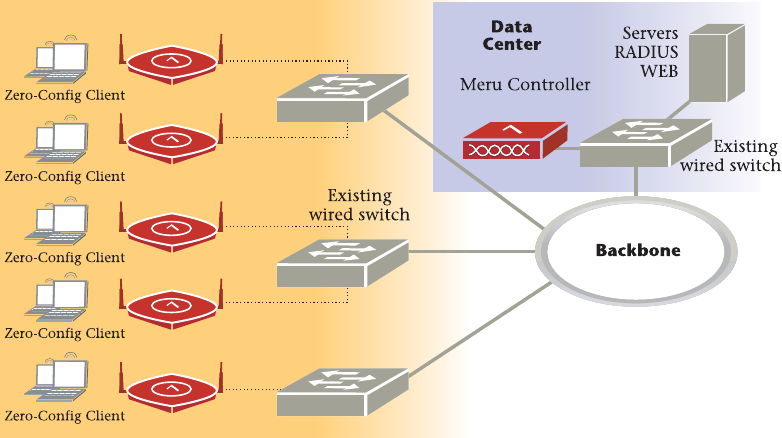
© 2010 Meru Networks, Inc. Access Points 1
Chapter 1
Access Points
Access Points contain radio devices that communicate with the Meru Controller and
form the wireless LAN (WLAN). The Meru Controller and Access Points connect to the
site’s wired LAN through wired switches. Wireless clients associate with the Access
Points as they roam throughout the WLAN. As such, they are an extension of the wired
LAN, providing the wireless benefits of client mobility, enhanced access, and
dynamic network configuration.
Figure 1: Wireless LAN Connected to Network
Meru AP

2Meru Access Point Installation Guide © 2010 Meru Networks, Inc.
AP400
AP400
The AP400 Access Point series delivers high performance, full-speed, Wi-Fi certified
802.11n based on draft 2.0 connectivity while simultaneously supporting legacy
802.11a/b/g devices. AP400 is available in the configurations shown below.
AP400 Configurations
Features for the AP400 include:
802.11n support with channel bonding in both 2.4GHz and 5GHz frequency bands.
Channel bonding combines two 20Mhz channels into a single-wide 40Mhz channel
for increased throughput.
Dual-band external antenna options optimized for MIMO mode.
Plug and Play deployment using centralized controller platforms.
Multi-layered security including standard WPA2, 802.11i security (such as
automatic traffic inspection).
Each of these Access points may be powered by a standard 802.3af or 802.3at PoE
device. However, in order to utilize all three radios in 3x3 operation, 802.3at PoE
is required.
Air Traffic Control technology for 802.11n devices and legacy a/b/g devices
3x3 MIMO with 3 chains and 3 receive chains, delivering two spatial streams
Channel span architecture which requires no channel planning or configuration
Eight standard multiband, omni-directional antennas for AP433e.
Powered by 5 volt DC input, 802.3af compliant PoE device, or draft 802.3at
compliant PoE device.
Model Configuration
AP433e Three dual-band 802.11n radios with 3x3 MIMO and external
antennas.
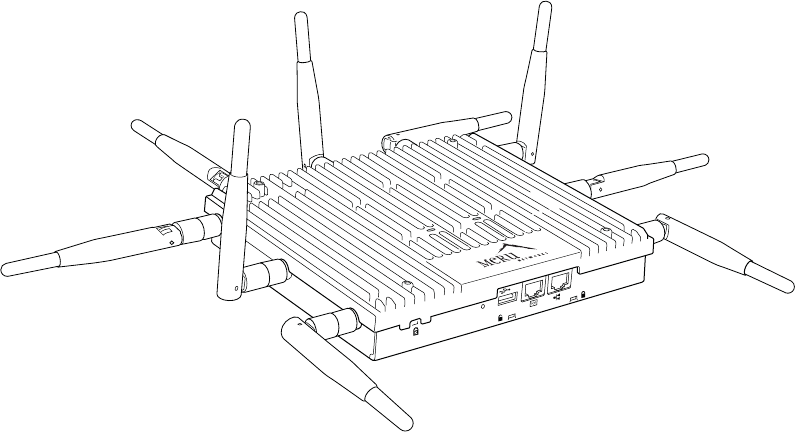
AP400
© 2010 Meru Networks, Inc. Access Points 3
Figure 2: AP400
RESET
CONSOLE
G1
USB
4Meru Access Point Installation Guide © 2010 Meru Networks, Inc.
AP400

Safety Precautions
© 2010 Meru Networks, Inc. Installing AP400 5
Chapter 2
Installing AP400
This chapter describes how to install and configure an AP400. It contains the following sections:
Safety Precautions
Unpack the AP400
Determine Power Requirements
Installation Requirements
Install the AP400
Check AP400 LED Activity
Check AP400 LED Activity
Where to Go From Here
Safety Precautions
IMPORTANT—Read and follow the regulatory instructions in Appendix B before installing and operating
this product.
If an optional power supply is used, it must be one supplied by Meru Networks.
The AP400 is intended only for installation in Environment A as defined in IEEE 802.3af. All intercon-
nected equipment must be contained within the same building, including the interconnected equip-
ment's associated LAN connection.
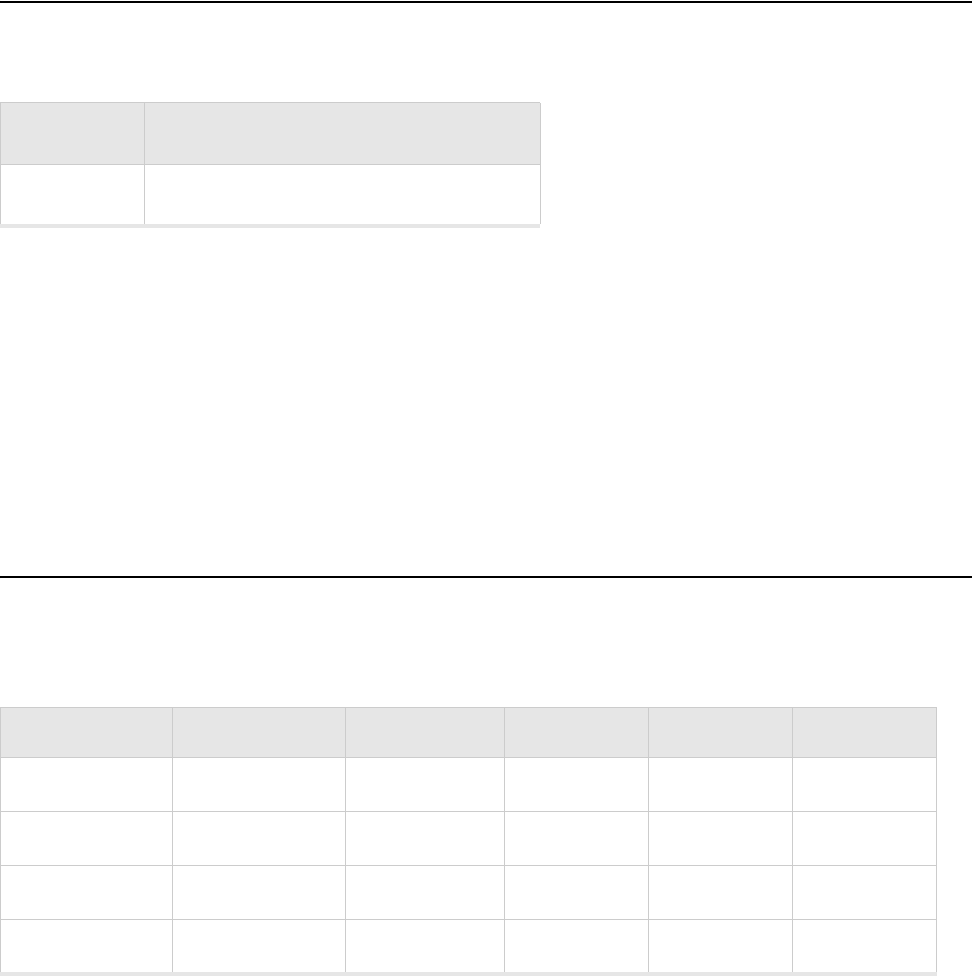
6Meru Access Point Installation Guide © 2010 Meru Networks, Inc.
Unpack the AP400
Unpack the AP400
The AP400 series has the following model(s) as shown below.
Confirm that the AP400 shipping package contains these items:
AP400
Eight antennas
Wall mounting bracket
Rubber feet
Locking pin
Determine Power Requirements
Power requirements vary, depending on which AP400 radios are deployed and what MIMO mode is used.
See the chart below for supported power sources for different radio configurations.
802.af PoE Usage
When using System Director 3.6 (or later) and 802.3af PoE, Meru supports radios set to any MIMO
settings except 3x3 on three radios. This is because three radios set to 3x3 MIMO using an 802.3af
switch may not have enough power if the cable is too long. Shorter cables frequently work, however.
Meru supports:
Model Radios
AP433e Three a/b/g/n
Radio 1 MIMO Radio 2 MIMO Radio 3 MIMO 802.3af PoE 802.3at PoE DC Power
2x2 2x2 2x2
2x2 3x3 3x3
3x3 2x2 3x3
3x3 3x3 3x3
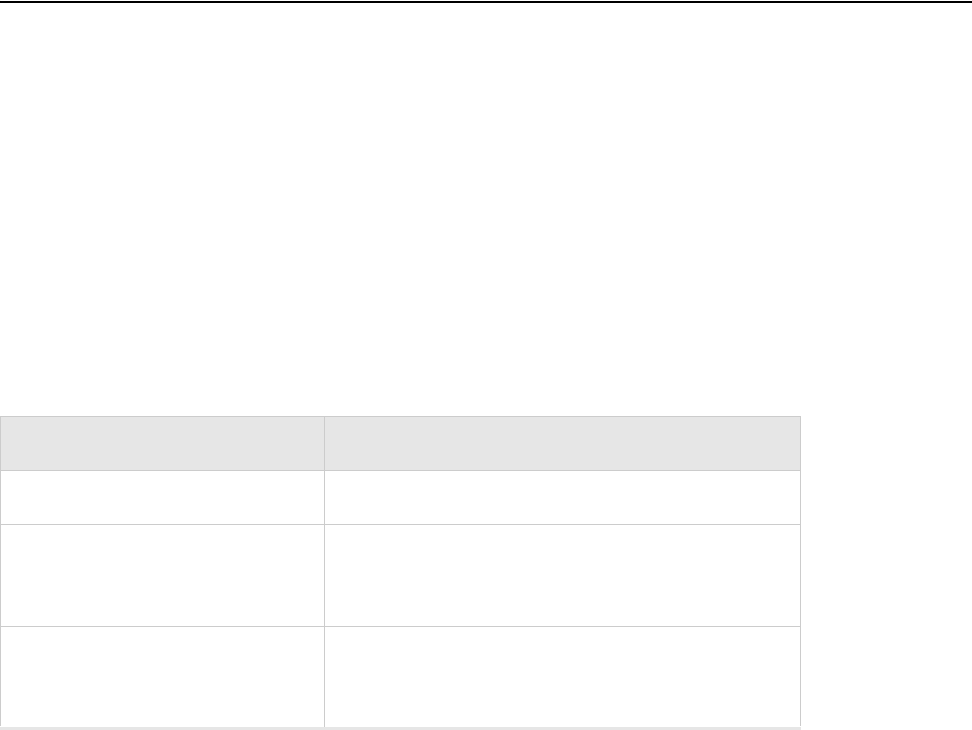
Installation Requirements
© 2010 Meru Networks, Inc. Installing AP400 7
Single or dual 3x3 radios
Three 2x2 radios
Three radios with one set to 2x2 and the other two set to 3x3
802.3at PoE Usage
When using System Director 3.6 (or later) and 802.3at, all possible configurations are supported. For
a list of supported PoEs, see the appendix Supported Power Over Ethernet Devices for Meru APs
Installation Requirements
An array of holes on the mounting bracket allows the AP400 to be mounted on the wall and over junc-
tion boxes or molly bolts. There are holes for passing the PoE Ethernet or external power supply cable
through the bracket if the bracket is mounted on a junction box.
The AP400 has a security cable slot so you can lock the AP400 with a standard security cable, such as
those used to secure laptop computers.
Purchase optional mounting kits to mount the AP400 either from the ceiling or inside an enclosure:
Above Suspended Ceiling Mounting Kit (T-Bar Hanger): ACC-MNT-ASCMKIT
Above hanging ceiling tiles. Suitable for use in environmental air space in accordance with the
Section 300-22(c) of the National Electric Code and Sections 2- 128.12 - 010 (3) and 12 - 100 of the
Canadian Electrical Code. Part 1. C22. 1.
To complete AP400 installation, you need the items listed below.
Installation Type Items Required
Horizontal mounting None
Vertical mounting over a wall
stud
Two #6 x 2" wood screws for a wood stud; or
Two #6 x 1½” metal screws for a metal stud
Mounting bracket
Vertical mounting on sheetrock
Two #6 x 1" screws
Two #4-6 x 7/8” ribbed plastic wall anchors
Mounting bracket

8Meru Access Point Installation Guide © 2010 Meru Networks, Inc.
Install the AP400
Additional Equipment
A power source is needed to power the AP400. See Determine Power Requirements.
Install the AP400
Select a Location
Attach the Provided Antennas
Install the Access Point
Select a Location
All AP400 interconnected equipment, including the associated LAN connection, must be contained
within the same building. In addition, the AP400 location should meet the following conditions:
Relatively unobstructed access to the stations the AP serves. Select a location with minimal physical
obstructions between the AP and the wireless stations. In an office with cubicles, mounting the APs
below a hanging ceiling (plenum is supported) or the wall near the ceiling provides the least
obstructed communications path. On a wall, orient the AP400 horizontally so that you can read the
Meru logo without tilting your head at 90 degrees - this orientation provides optimum MIMO
performance.
Access to wall outlet or a to a Power over Ethernet (PoE) connection to the network switch servicing
the controller.
We recommend planning for about 50 clients per radio (or per interference region) if you plan to
use Virtual Port and plan to have phones as clients. For a data-only installation, plan up to 128
clients per radio. Refer to the Meru Deployment Guides on the support site for more information.
AP400 is designed to provide 360 degree omni-directional coverage as illustrated below. Plan place-
ment with this pattern in mind.
Horizontal mounting below a
hanging ceiling
Two caddy fasteners
Two plastic spacers
Two keps nuts (with attached lock washer)
Mounting bracket
Mounting above a ceiling tile Mounting bracket ACC-MNT-ASCMKIT
Installation Type Items Required
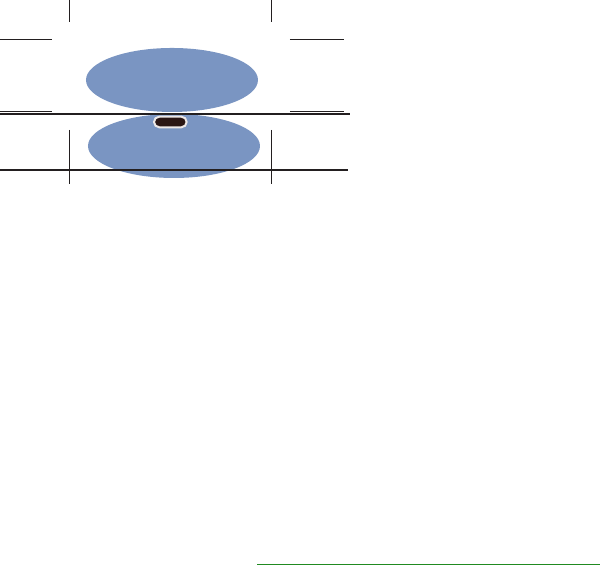
Install the AP400
© 2010 Meru Networks, Inc. Installing AP400 9
Figure 3: Coverage Pattern for AP400 When Ceiling Mounted
Most installations receive the best coverage using the following guidelines:
Install APs toward the center of the building.
Place APs about 80 feet apart.
Do not install APs near metal objects, such as heating ducts, metal doors, or electric service panels.
For best coverage, orient antennas as shown in Figure 6.
Attach the Provided Antennas
All AP400s have eight external antenna ports, labeled A1 - A8. These units operate with eight antennas
attached, even though some configurations don’t use all eight. Instead of attaching an antenna, you
can cap unused antenna connectors with 50 ohm Reverse Polarity SMA terminators. (For a list of
approved terminators, see http://support.merunetworks.com/.) Meru-supplied antennas are suitable
only for indoor use. To achieve the best performance from your AP400, position antennas at a 90 degree
angles relative to each other as shown in Figure 6. (The antennas do not have to be oriented exactly
as shown in the figure, but it is important to maintain the relative angles.) If for some reason you are
unable to maintain those angles, the network will still operate, but you may experience up to a 20%
drop in throughput depending on the antenna orientation.
ceiling
floor
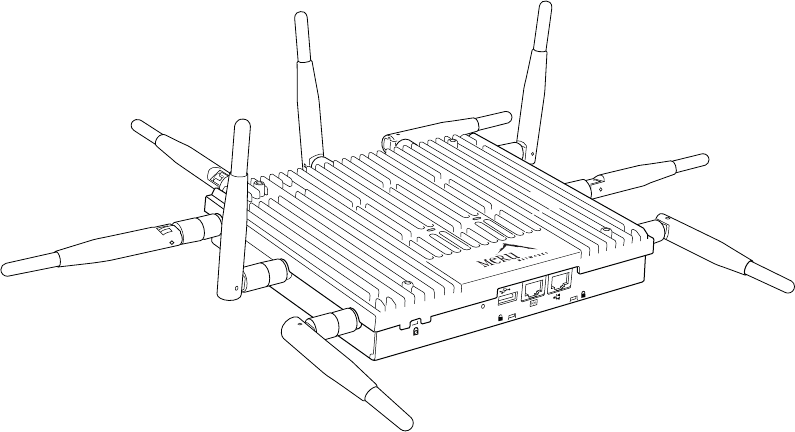
10 Meru Access Point Installation Guide © 2010 Meru Networks, Inc.
Install the AP400
Figure 6: AP400 Antennas in Ceiling and Wall Mount Configuration
Do not leave any antenna connectors unterminated. All connectors on the AP must be terminated with
antennas or with 50 ohm Reverse Polarity SMA terminators.
The attached antennas must be the same model; if you replace one antenna with a different type,
replace them all.
Install the Access Point
AP400 ships with a mounting bracket included in the box. This bracket is intended for installation as a
wall-mount; for mounting on a ceiling, no mount is typically required. See the following sections for
more specific details.
Mount AP400 Horizontally on a Shelf
Mount AP400 Vertically on a Wall
Mount AP400 Below a Suspended Ceiling
Mount AP400 Above a Suspended Ceiling (Plenum)
Mount AP400 Horizontally on a Shelf
When mounting an AP400 horizontally, no mounting bracket is required. Be sure to position the
antennas vertically when an AP400 sits on a surface. In order to ensure that the AP400 does not shift
much, attach the rubber feet provided in the box to the bottom of the AP.
Mount AP400 Vertically on a Wall
To mount an AP400 on a wall:
RESET
CONSOLE
G1
USB
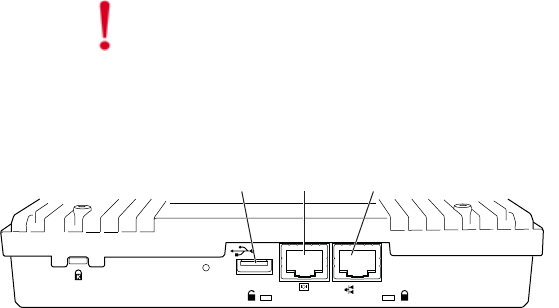
Install the AP400
© 2010 Meru Networks, Inc. Installing AP400 11
1. Using the holes on the mounting bracket itself as a guide, mark the location on the wall for the AP
bracket mounting screws. If possible, center the mounting screws on a wall stud. (If mounting on
a wall stud is impossible, use plastic wall anchors on the remaining screws.)
2. Orient the AP400 horizontally so that you can read the Meru logo without tilting your head at 90
degrees - this orientation provides optimum MIMO performance.
3. Drill holes at the locations you marked:
—3/16-inch holes if you are using plastic anchors
—1/8-inch holes if you are using only the screws
4. If you are using plastic anchors, install them in the holes.
5. Screw in the screws most of the way.
6. Mount the bracket on the screws, placing the circular portion of the keyhole mounts over the screw
heads and sliding the bracket down.
Figure 7: Mounting the AP to the Bracket
7. Connect one end of the Ethernet cable to the switch and the other end to the AP400 Ethernet port.
Figure 8: Ports and Unlock Mechanism for the AP400
8. If you are not using a PoE device, connect an external power supply to the power connector and
plug it into the wall.
Caution!
Be sure to connect the Ethernet cable to the Ethernet port; the cable can
mistakenly be plugged into the Console port. If you do this, the AP won’t power up.
RESET
USB
CONSOLE
G1
Console
port
Ethernet
port
USB
port
00260
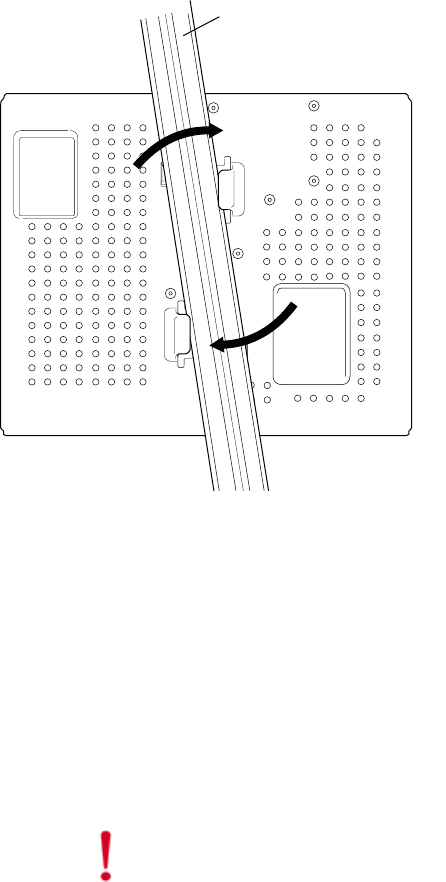
12 Meru Access Point Installation Guide © 2010 Meru Networks, Inc.
Install the AP400
Mount AP400 Below a Suspended Ceiling
The brackets on the bottom of the AP400 allow it to be mounted directly to a ceiling T-bar (see Figure
8). Note that the AP lock must be disabled by sliding the locking key (provided in the box) into the
unlock hole on the side of the AP shown in Figure 7 in order to clip the AP in place.
Figure 9: Mounting AP400 to a Suspended Ceiling Rail
To mount an AP400 below a suspended ceiling:
1. Determine the location on the ceiling rail where the AP will be mounted and remove the ceiling
tiles.
2. Verify that the AP is unlocked using the locking key on the unlock mechanism (on the same side as
the Ethernet ports).
3. Press the AP400 against the T-bar at a slight angle and then rotate into place, as indicated in Figure
8. You should hear it snap in place.
4. For each antenna, loosen the knurled ring at the base of the antenna, orient the antenna and then
retighten the ring.
5. Connect one end of the PoE Ethernet cable to the AP’s Ethernet port (see Figure 9).
Caution!
Be sure to connect the Ethernet cable to the Ethernet port; the cable can
mistakenly be plugged into the Console port. If you do this. the AP won’t power up.
T-bar
(in ceiling)
00261

Install the AP400
© 2010 Meru Networks, Inc. Installing AP400 13
Figure 10: Ports and Unlock Mechanism for the AP400
RESET
USB
CONSOLE
G1
Console
port
Ethernet
port
USB
port
00260

14 Meru Access Point Installation Guide © 2010 Meru Networks, Inc.
Install the AP400
Mount AP400 Above a Suspended Ceiling (Plenum)
Use the optional T-bar box hanger mounting kit to mount the AP400 above suspended ceiling T-rails
(see Figure 10). The installation attaches the T-bar box hanger to the ceiling rails and then the AP400
attaches to the T-bar box hanger. Note that an AP400 mounted above the ceiling has about 2-3 dBm
less RF coverage than an AP400 mounted under the ceiling.
Figure 11: AP400 Mounted Above a Suspended Ceiling Face Down
The AP400 with the metal enclosure exposed meets the requirements for fire resistance and low
smoke-generating characteristics required by Section 300-22(C) of the National Electrical Code (NEC)
for installation in a building’s environmental air space.
You may need to modify thicker tiles to support this installation.
To mount an AP400 above the ceiling with the optional T-bar kit, follow these steps:
1. Determine the location on the ceiling rails where the AP will be mounted and remove the ceiling
tile.
2. Unpack the T-bar hanger kit and attach the legs to the main support.
3. Attach the square bracket to the underside of the main support bar using the screws provided.
Warning!
When installed in air-handling spaces, such as above a suspended ceiling,
power the AP400 only with a PoE, not a power supply.
Warning!
Any Fast Ethernet (FE) cables installed in air-handling spaces should be
suitable under NEC Article 800.50 and marked accordingly for use in plenums and air-
handling spaces with regard to smoke propagation, such as CL2-P, CL3-P, MPP (Multi
Purpose Plenum), or CMP (Communications Plenum). Use Ethernet cable that meets
the requirements for operating in plenums and environmental air space in
accordance with Section 300-22(C) of the NEC.
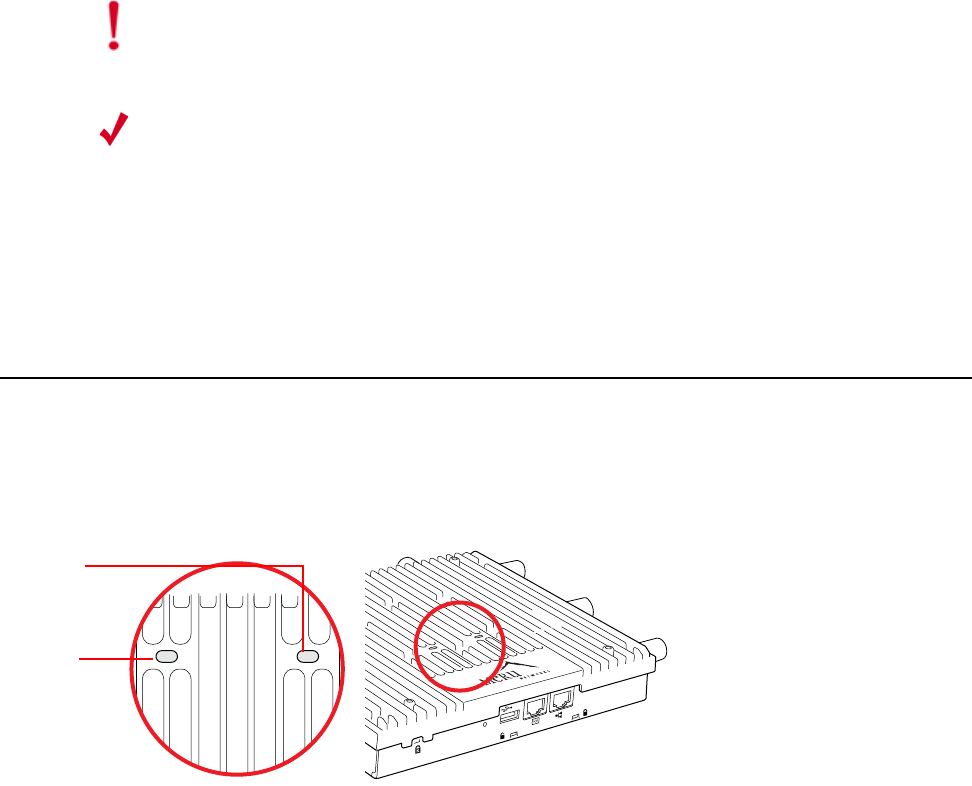
Check AP400 LED Activity
© 2010 Meru Networks, Inc. Installing AP400 15
4. Verify that the AP400 is unlocked using the locking key.
5. Brace your hand against the back of the main support bar and press the AP400 against the square
bracket in a similar manner to that indicated in Figure 8.
6. Twist until the AP400 clicks into place. If desired, you can now lock the AP using the locking key.
7. Mount the bracket and AP in the desired location by sliding the support arms onto the ceiling T-bars.
8. For each antenna, loosen the knurled ring at the base of the antenna, point the antenna down, then
retighten the ring.
9. Connect one end of the PoE Ethernet cable to the Ethernet connector.
10. Check that the AP400 is operating correctly before replacing the ceiling tile. Verify correct
operating using the LEDs, as shown in Check AP400 LED Activity.
Check AP400 LED Activity
When AP400 first connects to the controller (and any time the access point is rebooted), the AP initial-
izes and is then programmed by the controller. When the AP first powers up, all LEDs are green.
Figure 12: AP400 Status LEDs
After the AP400 is connected, check the status of the LEDs. The functions of the LEDs are described
below.
Caution!
Be sure to connect the Ethernet cable to the Ethernet port; the cable can
mistakenly be plugged into the Console port. If you do this. the AP won’t power up.
Note:
Use a shielded Cat 5e (or greater) Ethernet cable in order to comply with
international electromagnetic emissions limits.
RESET
CONSOLE
G1
USB
LEDs
00259
Activity
Power

16 Meru Access Point Installation Guide © 2010 Meru Networks, Inc.
Where to Go From Here
AP400 LED Descriptions
Change LED Appearance
If you want to change the appearance of the LEDS, follow these steps:
1. From the controller, click Configuration > Devices > AP, and then select the AP.
2. Select one of these settings for the LED Mode setting:
—Normal: LEDs are as described above
—Blink: Sets all LEDs flashing; this is useful to locate an AP
—Dark: Turns off all LEDs
3. Click OK.
Where to Go From Here
Now that the AP400 is installed, refer to the Meru System Director Getting Started Guide for instruc-
tions on initializing the hardware. Return to this chapter to check the status of the LEDs once the WLAN
is operational.
LED Function Troubleshooting
Power off—no power
green—presence of power
Status
off—no power
green—booting stage 1
blinking green and off—booting stage 2
blinking green and white—discovering the
controller
blinking green and blue—downloading a
configuration from the controller
blinking blue and off—AP is online and
enabled, working state
blinking red and yellow—failure; consult
controller for alarm state
If the status LED is blinking red and
yellow, there is an alarm on the AP.
Determine what the alarm is by
clicking Monitor > Dashboard >
Alarms and looking at the AP alarms.
You can also use the CLI commands
show alarm and show log.

Cautions
© 2010 Meru Networks, Inc. Cautions and Warnings 17
Appendix A
Cautions and Warnings
The cautions and warnings that appear in this manual are listed below in English,
German, French, and Spanish.
Cautions
A Caution calls your attention to a possible hazard that can damage equipment.
"Vorsicht” weist auf die Gefahr einer möglichen Beschädigung des Gerätes in.
Une mise en garde attire votre attention sur un risque possible d'endommagement de
l'équipement. Ci-dessous, vous trouverez les mises en garde utilisées dans ce manuel.
Un mensaje de precaución le advierte sobre un posible peligro que pueda dañar el
equipo. Las siguientes son precauciones utilizadas en este manual.
Caution!
When changing the orientation of the antennas, be sure to slightly loosen the
knurled ring before moving the antenna. Retighten the ring afterward. Otherwise, you
might damage the internal cabling in the AP.
Vorsicht!
Bei einer Neuausrichtung der Antennen muss vor Bewegung der Antenne der
Rändelring leicht gelockert werden. Anschließend den Ring wieder festziehen.
Anderenfalls können die internen Kabel im AP beschädigt werden.
Mise en garde
En cas de modification d’orientation des antennes, veiller à desserrer
légèrement la bague moletée avant de réorienter l’antenne. Resserrer ensuite la bague,
faute de quoi le câblage interne du point d’accès pourrait être endommagé.
Precaución!
Al cambiar la orientación de las antenas, asegúrese de aflojar ligeramente
el anillo estriado antes de mover la antena. Luego vuelva a apretar el anillo. De otro modo,
podría dañar el cableado interno del punto de acceso.

18 Meru Access Point Installation Guide © 2010 Meru Networks, Inc.
Cautions
Caution!
Be sure to connect the Ethernet cable to the Ethernet port; the cable can
mistakenly be plugged into the Console port.
Vorsicht!
Darauf achten, dass das Ethernetkabel am Ethernetanschluss und nicht
versehentlich am Konsolenanschluss angeschlossen wird.
Mise en garde
Veiller à bien connecter le câble Ethernet au port Ethernet et non pas au
port Console.
Precaución!
Asegúrese de conectar el cable Ethernet al puerto Ethernet, porque por
error se puede enchufar en el puerto de la consola.
Caution!
The radiated output power of the access points is well below the FCC radio
frequency exposure limits. However, the Meru Access Point should be used in such a
manner that the potential for human contact during normal operation is minimized. To
avoid the possibility of exceeding the FCC radio frequency exposure limits, you should keep
a distance of at least 20 cm between you (or any other person in the vicinity) and the
Access Point antennas.
Vorsicht!
Die abgestrahlte Ausgangsleistung von Geräten von Meru Networks, Inc. liegt
weit unter den Hochfrequenz-Expositionsgrenzwerten der FCC. Die Meru Access Point
Zugangspunkte von Meru Networks, Inc. sollten jedoch so verwendet werden, dass das
Potenzial für Kontakt mit Menschen während des normalen Betriebs auf ein Mindestmaß
beschränkt wird. Um die Möglichkeit einer Überschreitung der FCC-Hochfrequenz-
Expositionsgrenzwerte zu vermeiden, ist ein Abstand von mindestens 20 cm zwischen Ihnen
(bzw. einer anderen Person in der Nähe) und den Zugangspunkt-Antennen zu wahren.
Mise en garde
La puissance de rayonnement émise par les équipements Meru Networks,
Inc. est très inférieure aux limites d'exposition aux fréquences radio définies par la FCC.
Toutefois, les points d'accès de la série Meru Access Point de Meru Networks, Inc. doivent
être utilisés de façon à éliminer tout risque de contact humain en fonctionnement normal.
Pour éviter de dépasser les limites d'exposition aux fréquences radio définies par la FCC,
il est impératif de préserver en permanence une distance supérieure ou égale à 20 cm
entre l'utilisateur (ou toute personne se trouvant à proximité) et les antennes du point
d'accès.
Precaución!
La potencia de radiación de los dispositivos de Meru Networks, Inc. está
muy por debajo de los límites de exposición a radiofrecuencia estipulados por la FCC. No
obstante, los puntos de acceso de la serie Meru Access Point de Meru Networks, Inc. deben
usarse de tal manera que se minimice la posibilidad de contacto para el usuario durante la
operación normal. Para evitar la posibilidad de exceder los límites de exposición a
radiofrecuencia establecidos por la FCC, el usuario (o cualquier otra persona en torno)
debe mantenerse a una distancia de al menos 20 cm respecto a las antenas del punto de
acceso.

Warnings
© 2010 Meru Networks, Inc. Cautions and Warnings 19
Warnings
A warning calls your attention to a possible hazard that can cause injury or death.
The following are the warnings used in this manual.
"Achtung" weist auf eine mögliche Gefährdung hin, die zu Verletzungen oder Tod
führen können. Sie finden die folgenden Warnhinweise in diesem Handbuch:
Un avertissement attire votre attention sur un risque possible de blessure ou de
décès. Ci-dessous, vous trouverez les avertissements utilisés dans ce manuel.
Una advertencia le llama la atención sobre cualquier posible peligro que pueda
ocasionar daños personales o la muerte. A continuación se dan las advertencias
utilizadas en este manual.
Caution!
Exposure to Radio Frequency Radiation.
The installer of this radio equipment must ensure that the antenna is located or pointed
such that it does not emit an RF field in excess of Health Canada limits for the general
population; consult Safety Code 6, obtainable from Health Canada’s website
http://www.hc-sc.gc.ca/rpb.
Vorsicht!
Exposure to Radio Frequency Radiation.
The installer of this radio equipment must ensure that the antenna is located or pointed
such that it does not emit an RF field in excess of Health Canada limits for the general
population; consult Safety Code 6, obtainable from Health Canada's website
http://www.hc-sc.gc.ca/rpb.
Mise en garde
Exposition aux rayonnements à fréquence radioélectrique
L'installateur de cet équipement radio doit veiller à positionner et orienter l'antenne
de telle sorte qu'elle n'émette pas un champ radioélectrique supérieur aux limites
définies par Santé Canada pour la population générale. Consulter le Code de sécurité
n° 6, disponible sur le site Web de Santé Canada à l'adresse http://www.hc-
sc.gc.ca/rpb.
Precaución!
Exposición a la radiación de radiofrecuencia.
El instalador de este equipo de radio debe cerciorarse de que la antena está local-
izada u orientada de tal manera que no emita un campo de radiofrecuencia superior
a los límites estipulados por Health Canada para la población; consulte el Código de
Seguridad 6 que podrá encontrar en el página web de Health Canada, http://www.hc-
sc.gc.ca/rpb.

20 Meru Access Point Installation Guide © 2010 Meru Networks, Inc.
Warnings
Warning!
With plastic covers removed, this product is suitable for use in
environmental air space in accordance with the Section 300-22(c) of the National
Electric Code and Sections 2- 128.12 - 010 (3) and 12 - 100 of the Canadian Electrical
Code. Part 1. C22. 1. For other countries, consult local authorities for regulations.
Achtung!
Bei abgenommener Kunststoffabdeckung ist dieses Produkt zur Verwendung
in einem Umgebungsluftraum gemäß Abschnitt 300-22(c) des National Electric Code
und Abschnitt 2- 128.12 - 010 (3) und 12 - 100 des Canadian Electrical Code Teil 1.
C22.1 geeignet. Die Vorschriften für andere Länder sind bei den örtlichen Behörden
erhältlich.
Avertissement
Sous réserve que ses couvercles de plastique soient déposés, cet
appareil est adapté à une utilisation dans les vides de construction des bâtiments
selon la section 300-22(c) du code NEC (National Electric Code) et les sections 2-
128.12 - 010 (3) et 12 - 100 du Code électrique du Canada, partie 1. C22. 1. Pour tous
les autres pays, consulter les organismes de réglementation locaux.
Advertencia
Una vez desprendidas las cubiertas de plástico, este producto es
adecuado para su uso en el espacio aéreo circundante en conformidad con la sección
300-22(c) del National Electric Code (Código Eléctrico Nacional de EE.UU.) y las
secciones 2- 128.12 - 010 (3) y 12 - 100 del Código Eléctrico de Canadá. Parte 1. C22.
1. En otros países, consulte a las autoridades locales competentes para informarse
acerca de las normativas vigentes.
Warning!
Any Fast Ethernet (FE) cables installed in air-handling spaces should be
suitable under NEC Article 800.50 and marked accordingly for use in plenums and air-
handling spaces with regard to smoke propagation, such as CL2-P, CL3-P, MPP (Multi
Purpose Plenum), or CMP (Communications Plenum).
Achtung!
Alle Fast-Ethernet (FE)-Kabel, die in Lüftungsräumen installiert werden,
sollten gemäß NEC Artikel 800.50 geeignet sein und entsprechend zur Verwendung in
Hohlräumen (Plenum) und Lüftungsräumen im Hinblick auf Rauchausbreitung
gekennzeichnet sein, z.B. CL2-P, CL3-P, MPP (Multi Purpose Plenum) oder CMP
(Communications Plenum).
Avertissement
Les câbles Fast Ethernet (FE) installés dans un vide d’air doivent
correspondre aux critères de l’article 800.50 du code NEC et identifiés en
conséquence comme adaptés à une utilisation dans les vides de construction des
bâtiments en matière de propagation de la fumée (marquages CL2-P, CL3-P, MPP
(Multi Purpose Plenum) ou CMP (Communications Plenum)).
Advertencia
Todos los cables Fast Ethernet (FE) instalados en espacios aéreos
deben cumplir con el artículo 800.50 del NEC y estar marcados adecuadamente para
su uso en espacios aéreos y plenums en lo concerniente a la propagación de humo,
tales como CL2-P, CL3-P, MPP (Plenum multifuncional), o CMP (Plenum de
comunicaciones).

Warnings
© 2010 Meru Networks, Inc. Cautions and Warnings 21
Warning!
Inside antennas must be positioned to observe minimum separation of 20
cm. (~ 8 in.) from all users and bystanders. For the protection of personnel working
in the vicinity of inside (downlink) antennas, the following guidelines for minimum
distances between the human body and the antenna must be observed.
The installation of the indoor antenna must be such that, under normal conditions,
all personnel cannot come within 20 cm. (~ 8.0 in.) from any inside antenna.
Exceeding this minimum separation will ensure that the employee or bystander does
not receive RF-exposure beyond the Maximum Permissible Exposure according to FCC
CFR 47, section 1.1310 i.e. limits for General Population/Uncontrolled Exposure.
Achtung!
Innenantennen müssen so positioniert werden, dass ein Mindestabstand von
20 cm (ca. 8 Zoll) zu allen Benutzern und anderen Personen gewahrt wird. Zum Schutz
von Personal, das in der Nähe von Innenantennen (Downlink) arbeitet, sind die
folgenden Richtlinien für Mindestabstand zwischen dem menschlichen Körper und der
Antenne zu beachten.
Die Innenantenne muss so installiert werden, dass sich unter normalen Bedingungen
kein Personal bis auf weniger als 20 cm (ca. 8 Zoll) an eine Innenantenne annähern
kann. Durch Überschreitung dieses Mindestabstands wird sichergestellt, dass Mitar-
beiter oder andere Personen keiner RF-Exposition über die maximal zulässige Expo-
sition (MPE; Maximum Permissible Exposure) gemäß FCC CFR 47, Abschnitt 1.1310
(Grenzwerte für die allgemeine Bevölkerung/unkontrollierte Exposition) ausgesetzt
werden.
Avertissement
Les antennes intérieures doivent être positionnées de façon à
respecter une distance minimum de 20 cm par rapport aux utilisateurs et aux tiers.
Pour la protection du personnel travaillant à proximité des antennes intérieures
(liaison descendante), respecter les directives suivantes pour assurer des distances
minimales entre les êtres humains et les antennes.
Toute antenne intérieure doit être installée de telle sorte que, dans des conditions
normales, le personnel ne puisse s'en approcher à moins de 20 cm. Cette distance
minimale est destinée à garantir qu'un employé ou un tiers ne sera pas exposé à un
rayonnement radioélectrique supérieur à la valeur maximale autorisée, telle qu'elle
est définie dans les limites d'exposition non contrôlées pour la population par la
réglementation de la FCC CFR 47, section 1.1310.
Advertencia
Las antenas interiores deben colocarse de manera que se observe una
separación mínima de 20 cm. (~ 8 pulg.) respecto a todos los usuarios y circunstantes.
Para la protección del personal que trabaje en las inmediaciones de las antenas
interiores (receptoras), deben observarse las siguientes directrices relativas a la
distancia mínima entre el cuerpo humano y la antena.
La instalación de la antena interior debe efectuarse de tal modo que, en condiciones
normales, ningún miembro del personal pueda acercarse a menos de 20 cm. (~ 8,0
pulg.) de cualquier antena interior. El cumplimiento de este mínimo de separación
asegura que el empleado o circunstante no recibirá exposición a radiofrecuencia por
encima de la Exposición Máxima Permisible conforme a la normativa FCC CFR 47,
sección 1.1310, es decir, los límites asignados a la Exposición Incontrolada/Población
Civil.
22 Meru Access Point Installation Guide © 2010 Meru Networks, Inc.
Warnings

For AP400
© 2010 Meru Networks, Inc. Regulatory Information 23
Appendix B
Regulatory Information
The Meru Access Point (APs) must be installed and used in strict accordance with the
manufacturer’s instructions as described in the user documentation that comes with
the product. For country-specific approvals, see below. Meru Networks, Inc. is not
responsible for any radio or television interference caused by unauthorized modifi-
cation of APs, or the substitution or attachment of connecting cables and equipment
other than that specified by Meru Networks, Inc. The correction of interference
caused by such unauthorized modification, substitution or attachment is the respon-
sibility of the user. Meru Networks, Inc. and its authorized resellers or distributors
are not liable for any damage or violation of government regulations that may arise
from the user failing to comply with these guidelines.
For AP400
Radio
FCC Part 15
Canada RSS210
EN 300 328 V1.6.1 (11/2004)
EN 301 893 V1.3.1 (08/2005)
Japan Technical Regulations
EMC
FCC Part 15
EN 301 489-17 V1.2.1 (08/2002)
Japan VCCI
Safety
Prolonged exposure to RF radiation can be hazardous. Switch off unit power before
service or installation procedures.

24 Meru Access Point Installation Guide © 2010 Meru Networks, Inc.
For AP400
Limits for Occupational/Controlled Exposure
Limits for General Population/Uncontrolled Exposure
Frequencies Blocked for Regulatory Compliance
802.11a frequencies 5.25-5.35 GHz and 5.47-5.725 GHz have been blocked for DFS
compliance.
Frequency
Range (MHz)
Electric Field
Strength (E)
(V/m)
Magnetic
Field Strength
(H) (A/m)
Power Density
(S) (mW/cm2)
Averaging
Time |E|2,
|H|2 or S
(minutes)
1500-100,000 5 6
Frequency
Range (MHz)
Electric Field
Strength (E)
(V/m)
Magnetic
Field Strength
(H) (A/m)
Power Density
(S) (mW/cm2)
Averaging
Time |E|2,
|H|2 or S
(minutes)
1500-100,000 1.0 30
Note:
Occupational/controlled limits apply in situations in which persons are exposed as a
consequence of their employment provided those persons are fully aware of the potential
for exposure and can exercise control over their exposure. Limits for
occupational/controlled exposure also apply in situations when an individual is transient
through a location where occupational/controlled limits apply provided he or she is made
aware of the potential for exposure.
Note:
General population/uncontrolled exposures apply in situations in which the general
public may be exposed, or in which persons that are exposed as a consequence of their
employment may not be fully aware of the potential for exposure or can not exercise
control over their exposure.

USA
© 2010 Meru Networks, Inc. Regulatory Information 25
USA
Underwriters Laboratories
For the AP150, AP300, AP400, AP1000, and the OAP180 series, the following state-
ment and notices are applicable:
Use only with Listed I.T.E. equipment.
Notices
The unit is intended for installation in Environment A as defined in IEEE 802.3.af. All
interconnected equipment must be contained within the same building, including the
interconnected equipment's associated LAN connection.
Suitable for use in environmental air space in accordance with Section 300-22(c) of
the National Electrical Code, and Sections 2-128, 12-010(3) and 12-100 of the Cana-
dian Electrical Code, Part 1, C22.1.
FCC Radiation Exposure Statement
Radio Frequency Interference Requirements
The Interference Statement applies to the following APs:
AP150
OAP180
AP1000
AP300
AP400
Caution!
The radiated output power of the Meru Networks devices is well below the FCC
radio frequency exposure limits. However, the Access Point should be used in
such a manner that the potential for human contact during normal operation is
minimized. When installing and operating these devices, keep a minimum
distance of 20 cm (8 inches) between the antennas and any persons/users in the
vicinity.

26 Meru Access Point Installation Guide © 2010 Meru Networks, Inc.
USA
Interference Statement
This device complies with Part 15 of the FCC Rules. Operation is subject to the
following two conditions: (1) This device may not cause harmful interference, and
(2) this device must accept any interference received, including interference that
may cause undesired operation.
This equipment has been tested and found to comply with the limits for a Class B
digital device, pursuant to Part 15 of the FCC Rules. These limits are designed to
provide reasonable protection against harmful interference in a residential installa-
tion. This equipment generates, uses, and can radiate radio frequency energy. If the
equipment is not installed and used in accordance with the instructions, the equip-
ment may cause harmful interference to radio communications. There is no guar-
antee, however, that such interference will not occur in a particular installation. If
this equipment does cause harmful interference to radio or television reception
(which can be determined by turning the equipment off and on), the user is encour-
aged to try to correct the interference by taking one or more of the following
measures:
Reorient or relocate the receiving antenna.
Increase the separation between the equipment and receiver.
Connect the equipment into an outlet on a circuit different from to which the
receiver is connected.
Consult the dealer or an experienced radio/TV technician for help.
This device must not be co-located or operating in conjunction with any other
antenna or transmitter.
For products available in the USA and Canadian markets, only channels 1 through 11
can be operated. Selection of other channels is not authorized.
Note:
Meru Access Points
All devices except the OAP180 are indoor devices. The FCC requires indoor use for
the frequency range 5.15 GHz to 5.25 GHz to reduce the potential for harmful
interference to co-channel Mobile Satellite systems.
High-power radars are allocated as primary users of the 5.25 to 5.35 GHz and 5.65
to 5.85 GHz bands. These radar stations can cause interference with or damage to
these devices, or both.
Note:
The Meru Access Point must be installed and used in strict accordance with the
manufacturer’s instructions as described in the user documentation that comes
with the product. Any other installation or use may violate FCC Part 15
regulations. Modifications not expressly approved by Meru Networks, Inc. could
void your authority to operate the equipment.

Canada. Industry Canada (IC)
© 2010 Meru Networks, Inc. Regulatory Information 27
Canada. Industry Canada (IC)
The Class B digital portion of this apparatus complies with Canadian standard ICES-
003.
These devices comply with RSS210 of Industry Canada.
Per RSS 210 A9.5 point 7:
(i) the device for the band 5150-5250 MHz is only for indoor usage to reduce potential
for harmful interference to co-channel mobile satellite systems;
(ii) the maximum antenna gain permitted (for devices in the bands 5250-5350 MHz
and 5470-5725 MHz) to comply with the e.i.r.p. limit; and
(iii) the maximum antenna gain permitted (for devices in the band 5725-5825 MHz)
to comply with the e.i.r.p. limits specified for point-to-point and non point-to-point
operation as appropriate, as stated in section A9.2(3).
In addition, users should also be cautioned to take note that high-power radars are
allocated as primary users (meaning they have priority) of the bands 5250-5350 MHz
and 5650-5850 MHz and these radars could cause interference and/or damage to LE-
LAN devices.
(iv) These devices are not permitted to operate in the 5600 - 5650 MHz band.
For products available in the USA and Canadian markets, only channels 1 through 11
can be operated. Selection of other channels is not authorized.
Operation is subject to the following two conditions: (1) this device may not cause
interference, and (2) this device must accept any interference, including interfer-
ence that may cause undesired operation of this device.
This device and its listed antenna(s) must not be co-located or operated in conjunc-
tion with any other antenna or transmitter
L’utilisation de ce dispositif est autorisée seulement aux conditions suivantes: (1) il
ne doit pas produire de brouillage et (2) l’utilisateur du dispositif doit étre prêt à
accepter tout brouillage radioélectrique reçu, même si ce brouillage est susceptible
de compromettre le fonctionnement du dispositif.
The term "IC" before the equipment certification number only signifies that the
Industry Canada technical specifications were met.
To reduce the potential radio interference to other users, the antenna type and gain
should be chosen so that the equivalent isotropically radiated power (EIRP) is not
more than that required for successful communication.
To prevent radio interference to the licensed service, this device is intended to be
operated indoors and away from windows to provide maximum shielding. Equipment
(or its transmit antenna) that is installed outdoors is subject to licensing.
Pour empecher que cet appareil cause du brouillage au service faisant l’objet d’une
licence, il doit etre utilze a l’interieur et devrait etre place lin des fenetres afin de
Fournier un ecram de blindage maximal. Si le matriel (ou son antenne d’emission) est
installe a l’exterieur, il doit faire l’objet d’une licence.

28 Meru Access Point Installation Guide © 2010 Meru Networks, Inc.
Canada. Industry Canada (IC)
Access Points have been designed to operate with the antennas listed below.
Antennas not included in this list are strictly prohibited for use with these devices.
The required antenna impedance is 50 ohms.
AP Antennas with Gain
To reduce potential radio interference to other users, the antenna type and its gain
should be chosen so that the equivalent isotropically radiated power (e.i.r.p.) is not
more than that permitted for successful communication.
Caution!
Exposure to Radio Frequency Radiation.
The installer of this radio equipment must ensure that the antenna is located or
pointed such that it does not emit an RF field in excess of Health Canada limits
for the general population; consult Safety Code 6, obtainable from Health
Canada’s website http://www.hc-sc.gc.ca/rpb.
This equipment complies with IC RSS-102 radiation exposure limits set forth for
an uncontrolled environment. This equipment should be installed and operated
with a minimum distance of 20cm between the antennas and any persons/users
in the vicinity.
Note:
Meru Access Points
These devices are restricted to indoor use because they operate in the 5.15 to
5.25 GHz frequency range. Industry Canada requires such products to be used
indoors for the frequency range 5.15 GHz to 5.25 GHz to reduce the potential
for harmful interference to co-channel Mobile Satellite systems.
AP Model Antenna Type Gain (2.4 GHz) Gain (5 GHz)
AP300 Dual-Band Omni-Directional
MN-ACC-ANTabg-W 2 dBi 3 dBi
AP300 Dual-Band Omni-Directional
ACC-ANT-ABGN-23 2 dBi 3 dBi
AP300 High-Gain Dipole Omni-Directional
ACC-ANT-ABGN47O 4.7dBi 4.7dBi
AP150 Dual-Band Omni-Directional
SAA04-220050 2 dBi 3 dBi

Europe—EU Declaration of Conformity and Restrictions
© 2010 Meru Networks, Inc. Regulatory Information 29
Europe—EU Declaration of Conformity and
Restrictions
EN 300 328. Electromagnetic Compatibility and Radio Spectrum Matters (ERM).
Wideband transmission systems, data transmission equipment operating in the 2.4
GHz ISM (Industrial, Scientific, and Medical frequency bands in the range of 902–928
MHz, 2.4–2.485 GHz, and 5.15–5.25 GHz) band and using spread spectrum modulation
techniques, harmonized EN standards covering essential requirements under article
3.2 of the R&TTE directive.
EN 301 893. Broadband Radio Access Networks (BRAN). 5 GHz high-performance
RLAN, harmonized EN standards covering essential requirements of article 3.2 of the
R&TTE directive.
EN 301 489-17. Electromagnetic Compatibility and Radio Spectrum Matters (ERM).
Electromagnetic Compatibility (EMC) Standard for Radio Equipment and Services,
Part 17 Specific Conditions for Wideband Data and HIPERLAN Equipment.
EN 55022 Statement (applicable to AP201 Rev 2, AP208 Rev 2 only).This is to certify
that the above models are shielded against the generation of radio interference in
accordance with the application of Council Directive 2004/108/EC, Annex I, 1a.
Conformity is declared by the application of EN 55 022 Class B (CISPR 22). Compliance
is dependent upon the use of Cat 5e shielded data cables.
EN 60950-1. Safety of Information Technology Equipment.
EN 50385. Product standard to demonstrate the compliances of radio base stations
and fixed terminal stations for wireless telecommunication systems with the basic
restrictions or the reference levels related to human exposure to radio frequency
electromagnetic fields.
This equipment is marked with either the CE Mark, the alert symbol, and the notified
body's number and can be used throughout the European Community. This mark indi-
cates compliance with the R&TTE Directive 1999/5/EC and the relevant parts of the
following technical specifications.
This equipment is marked with either the CE Mark, the alert symbol, and the notified
body's number and can be used throughout the European Community. This mark indi-
cates compliance with the R&TTE Directive 1999/5/EC and the relevant parts of the
following technical specifications.
Marking by the alert symbol indicates that usage restrictions apply.

30 Meru Access Point Installation Guide © 2010 Meru Networks, Inc.
Europe—EU Declaration of Conformity and Restrictions
Meru Networks, Inc. declares that their Access Points comply with the essential
requirements and other relevant provisions of Directive 1999/5/EC.
Meru Networks, Inc. vakuuttaa täten että Access Points tyyppinen laite on direktiivin
1999/5/EY oleellisten vaatimusten ja sitä koskevien direktiivin muiden ehtojen
mukainen.
Hierbij verklaart Meru Networks, Inc. dat het toestel Access Points in overeenstem-
ming is met de essentiële eisen en de andere relevante bepalingen van richtlijn
1999/5/EG.
Bij deze verklaart Meru Networks, Inc. dat deze Access Points voldoet aan de essen-
tiële eisen en aan de overige relevante bepalingen van Richtlijn 1999/5/EC.
Par la présente, Meru Networks, Inc. déclare que l’appareil Access Points est
conforme aux exigences essentielles et aux autres dispositions pertinentes de la
directive 1999/5/CE.
Par la présente, Meru Networks, Inc. déclare que ce Access Points est conforme aux
exigences essentielles et aux autres dispositions de la directive 1999/5/CE qui lui
sont applicables.
Härmed intygar Meru Networks, Inc. att denna Access Points står I överensstämmelse
med de väsentliga egenskapskrav och övriga relevanta bestämmelser som framgår av
direktiv 1999/5/EG.
Undertegnede Meru Networks, Inc. erklærer herved, at følgende udstyr Access Points
overholder de væsentlige krav og øvrige relevante krav i direktiv 1999/5/EF.
Hiermit erklärt Meru Networks, Inc. dass sich dieser/diese/dieses Access Points in
Übereinstimmung mit den grundlegenden Anforderungen und den anderen relevanten
Vorschriften der Richtlinie 1999/5/EG befindet.
Hiermit erklärt Meru Networks, Inc. die Übereinstimmung des Gerätes Access Points
mit den grundlegenden Anforderungen und den anderen relevanten Festlegungen der
Richtlinie 1999/5/EG.
Con la presente Meru Networks, Inc. dichiara che questo Access Points è conforme ai
requisiti essenziali ed alle altre disposizioni pertinenti stabilite dalla direttiva
1999/5/CE.
Por medio de la presente Meru Networks, Inc. declara que el Access Points cumple
con los requisitos esenciales y cualesquiera otras disposiciones aplicables o exigibles
de la Directiva 1999/5/CE.
Marking by the alert symbol indicates that usage restrictions apply.
Europe—EU Declaration of Conformity and Restrictions
© 2010 Meru Networks, Inc. Regulatory Information 31
Meru Networks, Inc. declara que este Access Points está conforme com os requisitos
essenciais e outras disposições da Directiva 1999/5/CE.
Hawnhekk, Meru Networks, Inc. jiddikjara li dan Access Points jikkonforma mal-htigi-
jiet essenzjali u ma provvedimenti ohrajn relevanti li hemm fid-Dirrettiva
1999/5/EC.
Käesolevaga kinnitab Meru Networks, Inc. seadme Access Points vastavust direktiivi
1999/5/EÜ põhinõuetele ja nimetatud direktiivist tulenevatele teistele asjako-
hastele sätetele.
Alulírott, Meru Networks, Inc. nyilatkozom, hogy a Access Points megfelel a vonat-
kozó alapvetõ követelményeknek és az 1999/5/EC irányelv egyéb elõírásainak.
Meru Networks, Inc. týmto vyhlasuje, e Access Points splna základné poiadavky a
všetky príslušné ustanovenia Smernice 1999/5/ES.
Meru Networks, Inc. tímto prohlašuje, e tento Access Points je ve shode se základními
poadavky a dalšími príslušnými ustanoveními smernice 1999/5/ES.
Šiuo Meru Networks, Inc. deklaruoja, kad šis Access Points atitinka esminius reikala-
vimus ir kitas 1999/5/EB Direktyvos nuostatas.
Ar šo Meru Networks, Inc. deklare, ka Access Points atbilst Direktivas 1999/5/EK
butiskajam prasibam un citiem ar to saistitajiem noteikumiem.
Niniejszym, Meru Networks, Inc., deklaruje, ze Access Points spelnia wymagania
zasadnicze oraz stosowne postanowienia zawarte Dyrektywie 1999/5/EC.
These products are intended to be used in all countries of the European Economic
Area with the following restrictions:
IEEE 802.11a Restrictions
These products are for indoor use only (5150–5250 MHz).
To ensure compliance with local regulations, be sure to set your Access Point to
the country in which you are using the Access Point.
The Meru Access Point products can be used only indoors in the following countries:
Austria, Belgium, Bulgaria, Czech Republic, Germany, Cyprus, Denmark, Estonia,
Finland, France, Greece, Hungary, Iceland, Ireland, Italy, Latvia, Lithuania,
Luxembourg, Malta, The Netherlands, Norway, Portugal, Poland, Romania, Spain,
Slovak Republic, Slovenia, Sweden, Switzerland, Turkey, and United Kingdom.
EEE 802.11b/g Restrictions
France—In all Metropolitan départements, wireless LAN frequencies can be used
under the following conditions, either for public or private use:
Indoor use: maximum power (EIRP) of 100 mW for the entire 2400–2483.5 MHz
frequency band.

32 Meru Access Point Installation Guide © 2010 Meru Networks, Inc.
Japan
Japan
EN 55022 Statement (applicable to AP201 Rev 2, AP208 Rev 2 only).This is to certify
that the above models are shielded against the generation of radio interference in
accordance with the application of Council Directive 2004/108/EC, Annex I, 1a.
Conformity is declared by the application of EN 55022 Class B (CISPR 22). Compliance
is dependent upon the use of shielded data cables.
Model AP300
Model AP150
Singapore
For the AP201 Rev 2, AP208 Rev 2, and OAP180, the following approval information
applies:
For the AP300 series, the following approval information applies:
Manufacturing Information
The AP150, AP1000, AP300, and AP400 are built in Taiwan. Factory information is
provided under NDA and upon request.
Model AP300 module rev 1
003WWA080094 003GZA080095 003XWA080096
003NY06122 0000 003GZ06030 0000 003WY06046 0000
DA103798
IDA Standards
Complies with
DB102245
IDA Standards
Complies with

Supported Power Over Ethernet Devices for Meru APs
© 2010 Meru Networks, Inc. Supported PoEs 33
Appendix C
Supported PoEs
Supported Power Over Ethernet Devices for
Meru APs
PoE Description
ACC-POE-AT-1AC Mid-Span High Power pre-802.3at PoE injector (1 Port, 110V/220V AC
input). Ideal for Meru AP300, AP300i, or AP1000; backward compatible
with 802.3af, also works with Meru AP150.
ACC-POE-AT-12AC Mid-Span 802.3af+ High Power PoE injector (12 Port, 110V/220V AC
input), 19" rack mountable, remote management capable. Ideal for
Meru AP300, AP300i, or AP1000.
ACC-POE1-24AC Mid-Span 802.3af PoE injector (24 Port, 110V/220V AC input) - Ideal for
Meru AP300, AP300i, or AP1000.
ACC-POE1-24ACDC Mid-Span 802.3af PoE injector (24 Port, 110V/220V AC or 48V DC input) - Note only
supports 20 access points?? Ideal for Meru AP300, AP300i, or AP1000.
34 Meru Access Point Installation Guide © 2010 Meru Networks, Inc.
Supported Power Over Ethernet Devices for Meru APs

Meru Networks, Inc.
894 Ross Drive
Sunnyvale, CA 94087
408-215-5300
www.merunetworks.com